![]() Short overview of loco - decoder interfaces
Short overview of loco - decoder interfaces
> main > model > control > nmra dcc
To fit a DCC decoder into your loco is not always an easy job, to make the job easier a number of interfaces have been developed over the years.
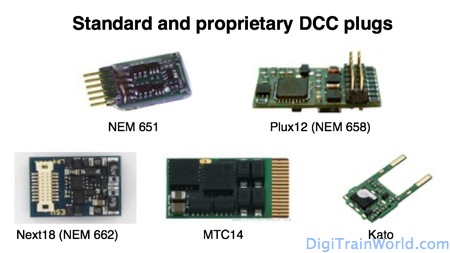 A few plug-in DCC decoders, all suitable for N-scale locos (photo by DigiTrainWorld)
A few plug-in DCC decoders, all suitable for N-scale locos (photo by DigiTrainWorld)
 Hard wired,
the oldest way to fit a decoder, a number of wires extend form the
decoder, usually some 150 mm (or 6 inches) long. These wires have to be
soldered to various parts of the loco (rail pickup, motor, lights etc.)
Conversion needs experience in fine electrical work and soldering skill
and may scare off less experienced and novice modellers.
Hard wired,
the oldest way to fit a decoder, a number of wires extend form the
decoder, usually some 150 mm (or 6 inches) long. These wires have to be
soldered to various parts of the loco (rail pickup, motor, lights etc.)
Conversion needs experience in fine electrical work and soldering skill
and may scare off less experienced and novice modellers.
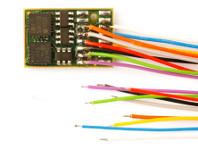 DH16A decoder by Doehler & Haass, showing the hardwired version (photo: Doehler & Haass)
DH16A decoder by Doehler & Haass, showing the hardwired version (photo: Doehler & Haass)
 A harness is used by some manufacurers, like Digitrax, TCS and ZTC. Wires are terminated on a plug, which plugs into the decoder.
The idea is that you install the harness first and then plug in the
decoder, to protect the valuable decoder from heat and possible static
discharges during the DCC conversion. Harnesses are usually available
as spares, toprovide an option for re-use of a decoder in another loco.
A harness is used by some manufacurers, like Digitrax, TCS and ZTC. Wires are terminated on a plug, which plugs into the decoder.
The idea is that you install the harness first and then plug in the
decoder, to protect the valuable decoder from heat and possible static
discharges during the DCC conversion. Harnesses are usually available
as spares, toprovide an option for re-use of a decoder in another loco.
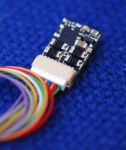 ZTC 255 harness-type decoder (photo: ZTC Controls)
ZTC 255 harness-type decoder (photo: ZTC Controls)
 The 8-pin plug
(NEM-652, NMRA-Medium or M) interface is used on many HO-scale
locomotives and a few N-scale locos (Kato USRA Mikado and a few other
steamers). The most common plug that has been around for a while. It
provides connections for a basic decoder (pickup, motor, 2 lights
and 1 extra function). Some modern 8-pin decoders have an integrated plug
and plug directly into the loco socket, a great space-saving idea.
The 8-pin plug
(NEM-652, NMRA-Medium or M) interface is used on many HO-scale
locomotives and a few N-scale locos (Kato USRA Mikado and a few other
steamers). The most common plug that has been around for a while. It
provides connections for a basic decoder (pickup, motor, 2 lights
and 1 extra function). Some modern 8-pin decoders have an integrated plug
and plug directly into the loco socket, a great space-saving idea.
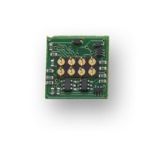 Digitrax DH165IP 8-pin plug-in decoder (photo: Digitrax)
Digitrax DH165IP 8-pin plug-in decoder (photo: Digitrax) 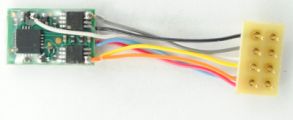 TCS M1P-1R decoder with NEM-652 plug on a short lead (photo: TCS)
TCS M1P-1R decoder with NEM-652 plug on a short lead (photo: TCS)
 The 6-pin plug
(NEM-651, NMRA-Small or S) interface is used in many N-scale locos and
some TT (1:120scale) locos. Originally introduced by Minitrix It only
offers basic connections (pickup, motor and directional front lights). The standard for
this plug offers room for interpretation; some manufacturers use
thinner wires on their decoders, others use square pins etc. sometimes
resulting in poor electrical contact. Some decoders have a short (up to 80 mm
or 2.5 inches) flat cable between plug and decoder, so that the decoder can
be located away from the plug.
The 6-pin plug
(NEM-651, NMRA-Small or S) interface is used in many N-scale locos and
some TT (1:120scale) locos. Originally introduced by Minitrix It only
offers basic connections (pickup, motor and directional front lights). The standard for
this plug offers room for interpretation; some manufacturers use
thinner wires on their decoders, others use square pins etc. sometimes
resulting in poor electrical contact. Some decoders have a short (up to 80 mm
or 2.5 inches) flat cable between plug and decoder, so that the decoder can
be located away from the plug.
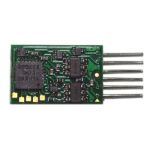 TCS EU651 decoder with NEM-651 interface (photo: TCS)
TCS EU651 decoder with NEM-651 interface (photo: TCS)  And the same decoder fitted with the plug attached to short wires (18mm) (photo: TCS)
And the same decoder fitted with the plug attached to short wires (18mm) (photo: TCS)
 Board replacements
are the 'American way' to convert N or HO scale locos to DCC. This
conversion is usually done easily, just swap the PCBs, analogue goes
out, DCC goes in and off you go. Drawback is that the decoder
manufacturers need to develop a new DCC board for every new loco on the
market, resulting in higher decoder prices and sometimes poor stocks at
the dealers. It may be clear that board replacements are limited to
popular locos. Digitrax and TCS offer a wide variety of replacement
boards, for most popular US proototype locos. Some of these baords fit
into Kato Japanese-prototype locos. Kato also have co-operated with
Digitrax to develop a DCC decoder that fits into Kato MUs. It comes as
3 different decoders: a motor-only decoder that slides between the pick
springs and motor connetions, a front/rear light function decoder and a
single-function decoder intended to switch interior lights on and off.
Board replacements
are the 'American way' to convert N or HO scale locos to DCC. This
conversion is usually done easily, just swap the PCBs, analogue goes
out, DCC goes in and off you go. Drawback is that the decoder
manufacturers need to develop a new DCC board for every new loco on the
market, resulting in higher decoder prices and sometimes poor stocks at
the dealers. It may be clear that board replacements are limited to
popular locos. Digitrax and TCS offer a wide variety of replacement
boards, for most popular US proototype locos. Some of these baords fit
into Kato Japanese-prototype locos. Kato also have co-operated with
Digitrax to develop a DCC decoder that fits into Kato MUs. It comes as
3 different decoders: a motor-only decoder that slides between the pick
springs and motor connetions, a front/rear light function decoder and a
single-function decoder intended to switch interior lights on and off.
 TCS K08D-A board-replacement DCC decoder, made to fit \a number of Kato models, it may fit a Kato EF81 and similar locos (photo: TCS)
TCS K08D-A board-replacement DCC decoder, made to fit \a number of Kato models, it may fit a Kato EF81 and similar locos (photo: TCS)
 PluX 8/12/16/22
(NEM-658) pin family. A new European development for a plug/socket
system that provides extra pins for extra functions, including sound
functions. Apart from the plug/scoket interface, the standards also
include the room where the decoder should go and maxiumum decoder size,
to make a conversion a simple plug-in operation. The long
downward-facing pins make
fitting this interface in an N-scale model an uneasy task for the
product engineers of the model manufacturers. In N-scale most models
with a PluX interface have a PluX12 socket, like Piko's E18 electric
express loco. PluX16 and up interfaces do not fit into N-scale models
and are only suitable for HO scale.
PluX 8/12/16/22
(NEM-658) pin family. A new European development for a plug/socket
system that provides extra pins for extra functions, including sound
functions. Apart from the plug/scoket interface, the standards also
include the room where the decoder should go and maxiumum decoder size,
to make a conversion a simple plug-in operation. The long
downward-facing pins make
fitting this interface in an N-scale model an uneasy task for the
product engineers of the model manufacturers. In N-scale most models
with a PluX interface have a PluX12 socket, like Piko's E18 electric
express loco. PluX16 and up interfaces do not fit into N-scale models
and are only suitable for HO scale.
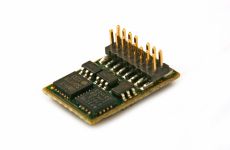 DH16A decoder by Doehler & Haass, with PluX16 interface (photo: Doehler & Haass)
DH16A decoder by Doehler & Haass, with PluX16 interface (photo: Doehler & Haass) 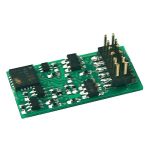 LD-G-31 deocoder with PluX12 interface, made by Tams Elektronik (photo: Tams Elektronik)
LD-G-31 deocoder with PluX12 interface, made by Tams Elektronik (photo: Tams Elektronik)
 MTC21
(NEM-660) was developed by Märklin and is now used by a number of
European manufacturers, mainly Märklin and Trix, and a few others in their loco models. Many
decoder manufacturers offer decoders for the MTC21 interface.
MTC21 decoders and MTC21 fiited models should carry a MTC21 logo
on their packaging. The size of the MTC21 plug precludes use in
HO-scale or O-scale models.
MTC21
(NEM-660) was developed by Märklin and is now used by a number of
European manufacturers, mainly Märklin and Trix, and a few others in their loco models. Many
decoder manufacturers offer decoders for the MTC21 interface.
MTC21 decoders and MTC21 fiited models should carry a MTC21 logo
on their packaging. The size of the MTC21 plug precludes use in
HO-scale or O-scale models.
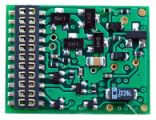 TCS EU621 decoder with MTC21 interface (photo: TCS)
TCS EU621 decoder with MTC21 interface (photo: TCS)
 Next18
(NEM-662) is meant as a successor to the NEM-651 6-pin interface,
eliminating the contact and compatibility problems of the 6-pin
interface and to overcome the problem of the space consuming long pins of the PluX
designs. The Next18 uses a plug that is widely used in modern mobile
phones and provides 18 pins. Enough for a sound decoder in N-scale.
Next18 decoders have their plug directly fiited on the decoder PCB.
Next18
(NEM-662) is meant as a successor to the NEM-651 6-pin interface,
eliminating the contact and compatibility problems of the 6-pin
interface and to overcome the problem of the space consuming long pins of the PluX
designs. The Next18 uses a plug that is widely used in modern mobile
phones and provides 18 pins. Enough for a sound decoder in N-scale.
Next18 decoders have their plug directly fiited on the decoder PCB.
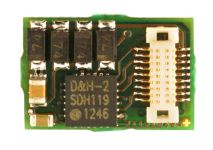 Doehler & Haass DH18A deooder with Next18 interface (photo: Doehler & Haass)
Doehler & Haass DH18A deooder with Next18 interface (photo: Doehler & Haass)
 MTC14,
not standardised yet is Minitrix' answer to solve the problems
encountered with the NEM-651 6-pin plug. At the moment Minitrix is the
only manufacturer that offers this interface, thus showing the Märklin
approach by developing something non-standard in an attempt to define a
standard on their own. Again a plug-in design,
but flatter than the Next18 or PluX designs, so very suitable for
N-scale models. Doehler and Haass offer decoders for this interface.
MTC14,
not standardised yet is Minitrix' answer to solve the problems
encountered with the NEM-651 6-pin plug. At the moment Minitrix is the
only manufacturer that offers this interface, thus showing the Märklin
approach by developing something non-standard in an attempt to define a
standard on their own. Again a plug-in design,
but flatter than the Next18 or PluX designs, so very suitable for
N-scale models. Doehler and Haass offer decoders for this interface.
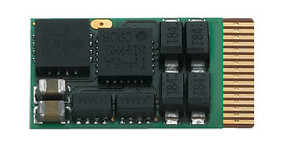 Minitrix 66840 decoder with MTC14 interface, made by Doehler & Haass (photo: Minitrix)
Minitrix 66840 decoder with MTC14 interface, made by Doehler & Haass (photo: Minitrix)
 Kato MU decoder, a small
decoder that slides betweeen the brass motor contact strips and the
pickup busbars of recent Kato EMU models. These include model for the
European (ICE4) and Japanese markets. Suitable decoders are made by
Digitrax and Zimo, the former are distributed through Kato, the latter
are distrubted through Lemke and thereá also a sound decoder available.
Kato MU decoder, a small
decoder that slides betweeen the brass motor contact strips and the
pickup busbars of recent Kato EMU models. These include model for the
European (ICE4) and Japanese markets. Suitable decoders are made by
Digitrax and Zimo, the former are distributed through Kato, the latter
are distrubted through Lemke and thereá also a sound decoder available.
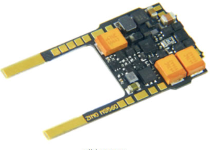 Zimo MS560 sound decoder, suitablel for Kato MUs (photo: Zimo)
Zimo MS560 sound decoder, suitablel for Kato MUs (photo: Zimo)
Pages written by Mark Veneman
< Back to the Digital Command Control page
 Modelling
Modelling Layouts
Layouts Modeller's
Corner
Modeller's
Corner  Train Simulators
Train Simulators  Various
Various